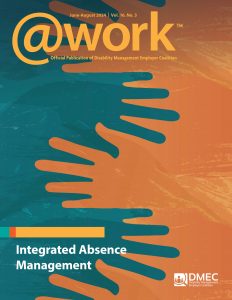The Disabled Workforce
Strategies for Managing Excessive Use of Leave
@Work Magazine, June 2024
By Rachel Shaw, MBA, Principal Consultant, Founder, Shaw HR Consulting
 Many employers that require in-person work are struggling under the highest levels of leave they have ever seen.1 Leave is not a new issue, but the levels of leave requested and being taken have caught human resources professionals by surprise. This is especially true for employees with nearly perfect attendance records who worked remotely during the pandemic.
Many employers that require in-person work are struggling under the highest levels of leave they have ever seen.1 Leave is not a new issue, but the levels of leave requested and being taken have caught human resources professionals by surprise. This is especially true for employees with nearly perfect attendance records who worked remotely during the pandemic.
Remote work discussions aside, how can integrated disability and absence management professionals handle an increasing number of employees calling out for medical reasons when they do not seem reasonable?
Employers will always have leave requests and must staff and budget for them. Humans get sick, they need vacations, and life simply happens. However, for many employers, there is a feeling that leave is being abused or used for inappropriate reasons, which can affect morale, profitability, and safety in the workplace. What employers want is employees to call out sick when they are sick, preschedule vacations and time off, and come to work when they are well.
If this is not your reality, you need a leave management plan that helps you understand your problem, develop a strategic plan, and execute it! The first step is to collect all relevant data points. You want to know the costs of needed and potentially unnecessary leave so when you address it, you can measure what is working to reduce the cost and impact of leave on your business.
A few steps to consider:
- Identify the problem. If you are not measuring and tracking leave usage, you can’t successfully tackle it. Start with payroll data on how much leave (paid time off and unpaid time off) is taken per month. When do most callouts happen? Is your leave usage mostly prescheduled or last-minute callouts? To assess the cost of leave, calculate direct (payroll) and indirect (substitute payroll, personnel to manage leave, loss of sales, overtime, etc.) costs.
- Be transparent and communicate leave concerns to all. Talk about your current leave usage and trends. Share concerns with employees and tell them why you are addressing the issue. If 85% of all days that fall under the federal Family and Medical Leave Act (FMLA) are taken on Mondays and Fridays, tell employees why this hampers productivity or safety. Discuss the effect of predictable and unpredictable leave, and communicate leave expectations to all employees. Consider confidential surveys and ask questions to help understand why employees are calling out. Knowing why may help you brainstorm solutions to reduce unnecessary leave.
- Develop a plan for FMLA leave users. For persons covered under FMLA leave, make sure to track the leave. If it exceeds certification levels, request recertification. If there are concerns that FMLA leave taken is not for legitimate medical reasons, talk with your legal team about a second or third opinion process. If employees use FMLA for prescheduled medical appointments, consider asking them to schedule appointments so they are not disruptive to operations. Also, inform them of their legal obligation to provide ample notice of appointments scheduled in advance. You can’t force employees to take leave when it is convenient for the team, but you can ask and require advanced notice when possible!
- Develop a plan for Americans with Disabilities Act (ADA) leave. When employees exhaust their FMLA, or if they don’t qualify for it, you may want to initiate a disability interactive process. Start by identifying your highest users, such as employees who have exhausted their FMLA leave every year for multiple consecutive years, or create a list of people who only call out on Fridays or Mondays, or during holiday periods when vacation is denied. Once you have this list, remove pregnancy-related disabilities and the accepted workers’ compensation leave users. The people who are left are protected by the ADA. Invite these employees into the interactive process to explore whether their leave is medically necessary, if there are alternatives to leave, and, if not, if the total leave needed is reasonable to accommodate.
Remember that reasonable accommodations should be explored for every employee who needs an extension of leave beyond FMLA and workers’ compensation! The purpose of this approach is to address the issue of employees who take high levels or patterned levels of leave and help them find alternative accommodations or life strategies so they can be at work more. This is not a disciplinary process. The goal is to reduce unnecessary leave that is affecting the company’s bottom line.
Reference
- AbsenceSoft’s 2023 Employee Leave of Absence Forecast Survey Results. Retrieved from https://absencesoft.com/resources/2023-leave-of-absence-forecast-survey/
DMEC-Related Resource

 Many employers that require in-person work are struggling under the highest levels of leave they have ever seen.1 Leave is not a new issue, but the levels of leave requested and being taken have caught human resources professionals by surprise. This is especially true for employees with nearly perfect attendance records who worked remotely during the pandemic.
Many employers that require in-person work are struggling under the highest levels of leave they have ever seen.1 Leave is not a new issue, but the levels of leave requested and being taken have caught human resources professionals by surprise. This is especially true for employees with nearly perfect attendance records who worked remotely during the pandemic.

